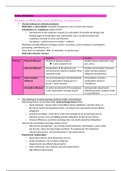PEOPLE DIMENSION
Chapter 4: Motivation and wellbeing of employees
1. The big challenge to motivate employees
- Motivation: a core problem in people management: law of action and reaction
- Commitment vs. compliance model of HRM
o Commitment of the employee is based on a calculation of possible advantages and
disadvantages and individual costs and benefits, and is mostly translated into
compliance (instead of active commitment)
o Compliance = performance (to comply = voldoen)
- Motivation through different strategies (money, incentives, social compliance, participation,
goal setting, commitment, etc.)
- Value chain of motivation: HRM motivation performance
- Motivation theories: Parsons
Negative Positive
External Physical influence (Threat of) physical violence Positive physical attention: hugs,
Least accepted form pat, caress
Material influence Manipulation of the physical and Positive remuneration: bonuses,
environmental material condition: fines, salary increase (leads to
reduction in pay utilitarian commitment)
Internal Social emotive Use of social pressure and membership Consultation, inclusion,
influence to an organization (‘being part of a participation (leads to
group’): social exclusion compliance)
Normative influence An active involvement of the employee Giving people valued work,
in the organization: feelings of guilt individual growth, purpose (leads
to commitment)
2. The importance of social exchange between leader and employee
- Influencing theory can be linked with social exchange theory (Blau)
o Social exchange = favours that create diffuse future obligations, and the nature of
the return cannot be bargained exactly, are longer term and entail trust and diffuse
obligations
o Economic exchange = short term, treat more tangible forms of exchange such as
material courses, focus on fulfilling specific obligations of the formal contract
o Greatest difference: economic exchange does not entail unspecified obligations
- Inducement-contribution exchange stands central
o Inducement (aansporing) : e.g. training and development, participation, career paths,
job security, salary and extra-legal incentives comprise the first dimension
‘offered inducement’. Second dimension is ‘job requirements’
- Employment relationships:
o Quasi-spot contract: both dimensions are low
o Under investment: not in balance (high job
requirements, low offered inducements)
o Over investment: not in balance (low job requirements,
high offered inducements)
, o Mutual investment: both dimensions are high (outperforms other relationships)
- Trust as the corner stone of social exchange
3. From compliance to commitment in HRM
- Commitment vs. control
o Cost reduction (cut labour costs; requires employee’s consent; a lot of influence for
unions which leads to consent or ‘compliance’) vs. commitment maximizers
(identification of employee with organization, leads to more trust between employer
and employee, increases employee’s involvement)
- Compliance and commitment:
o Compliance is passive, about working conditions, assumes conflicting interests
o Commitment is active, about intrinsic motivation, identification with the
organization, mutual trust
- AMO model (Appelbaum) & commitment model of HRM (Walton & Arthur)
o Commitment model leads to more participation in management decisions, greater
presence of formal collaboration systems, more attention to training in joint problem
solution, socialization programmes for (new) employees
o 3 components that can influence the discretionary behaviour of employee
Knowledge and competence (ability)
Incentives and stimuli (motivation)
Have the opportunity to make joint decisions and participate (opportunity)
4. The old theories of motivation: focus on article of Herzberg
- Maslow: the hierarchy of human needs
- Herzberg: about satisfiers and dissatisfiers,
or ‘One More Time: How Do You Motivate
Employees?’
Motivation (Herzberg):
- KITA = Kick In The Ass
o Negative physical kick: not possible
in our society, ethical and social
restrictions
o Negative psychological kick: less
stressed, but just as bad, not limited
practices, subtle but not as bad as
physical violence. Bullying at work
o Positive kick: remuneration, so called carrot
o PROBLEM: does not lead to intrinsic motivation
- Two-factor theory: hygiene factors and motivators
o Previous view: high job dissatisfaction <> high job
satisfaction
o Herzberg’s two-factor view:
Low job satisfaction <-Motivators-> High job
satisfaction
Low job dissatisfaction <-Hygiene-> High job
dissatisfaction





